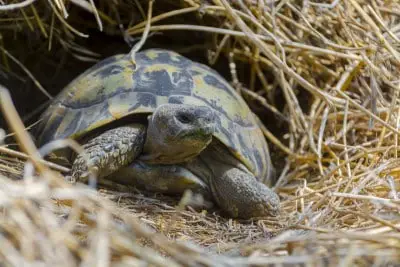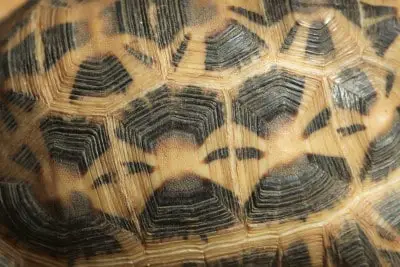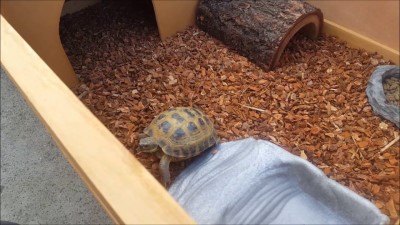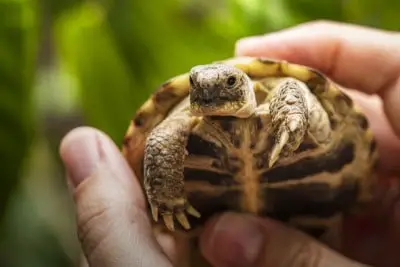Over the years, different tortoise species have adapted to living in various parts of the world. They have developed intricately designed internal and external organs, suitable for land life, even in the hottest and driest areas.
Unlike humans, tortoises have functioning tails. Also, the tails are different in size for both males and females since they perform different functions. If you have a male tortoise, don’t be surprised to see a lot of flashing and tail wagging.
Therefore, the tortoise has different body parts, each with a specific function(s). Read on to find out other interesting facts about the tortoise’s body.
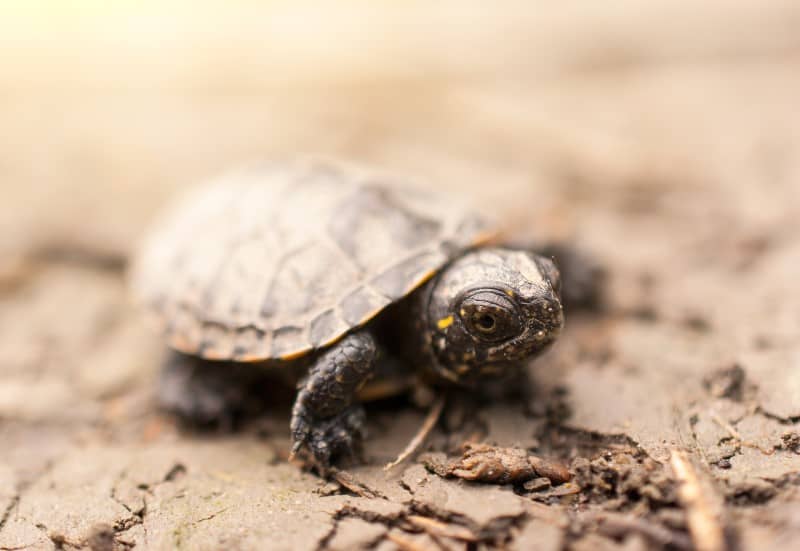
Do Tortoises Have Hair?
Tortoises are cold-blooded (ectothermic) creatures whose body temperature varies depending on their environment. On the other hand, mammals are warm-blooded, able to maintain their temperature regardless of their surroundings. Thanks to the hair and fur on their bodies, they can keep warm.
Reptiles, in contrast, have no such mechanism for warmth; they only have the scales and skin. Tortoises also lack hair, and instead, they have bare skin, dry in some areas. You wouldn’t find a strand of hair or fur on their head or body, even when they live in cold regions.
Do Tortoises Have Teeth?
The tortoise’s diet mostly consists of plants, and various species indulge in wild plants and vegetables. Its food choice varies depending on its species and the habitat. If it lives in arid areas, a tortoise can even munch on a prickly cactus. Pet tortoises, in contrast, can feed on any vegetable you provide
Unlike most animals, tortoises don’t have teeth. They have powerful beak-like mouths to help in grinding the food before they swallow. They use serrated edges around the mouth to bite and chew. These edges work like a bird’s bill to effectively chew all food types, depending on the tortoise’s diet.
Interestingly, river terrapins have rigid plates (secondary palates) on their jaws to aid them to grind any food they find in their habitats. Generally, tortoises don’t chew food as you do. Before they swallow, they bite using their strong jaws then let their saliva softens the food for them to enable eating. As a result, they end up gulping it down like a chunk.
Not having teeth doesn’t mean that tortoises don’t bite. Some carnivorous tortoises have lethal bites, able to tear off a finger or another animal’s limb. When in the wild, they use their beaks to bite each other, and, in some cases, the fights can turn out fatal. A giant tortoise can bite a chunk of another tortoise if need be. Moreover, if the food in their habitat is scarce, there are cases of tortoises turning to cannibalism.
Male tortoises also bite females when they want to initiate mating. It is an innate courting technique that acts as a tortoise’s mating ritual. Pet tortoises can again bite their keepers intentionally or accidentally first as a defense strategy, if they think of you as a predator or mistaking you for food, mainly when you hand feed them.
The bite’s intensity depends on the type of turtle and its size, with the pain ranging from mild to excruciating. Therefore, you need to be cautious around tortoises. If they bite you, it is advisable to seek medical attention immediately.
Do Tortoises Have Ears?
Many people assume that tortoises don’t have ears since they don’t protrude outwards like in most animals. Similarly, some believe that tortoises can’t hear because they don’t respond to loud noises or when you call them. The truth is these reptiles also have an auditory system; tortoises also have ears, but it isn’t an external one like yours.
Instead, they have a thin membrane that covers a soft circular spot on their head’s sides. You may not perceive it unless you take a closer look at the tortoise. The most easily observable features are the eyes, nostril, and mouth. The ear, in contrast, is towards the back of the head, behind the eyes.
Typically, tortoise ears can perceive low-frequency sounds, which enable them to communicate and navigate. Thus, they are more sensitive to low sounds than loud ones. Mother tortoises can even hear low frequencies such as eggs hatching and their young ones’ cries. Tortoises tend to ignore most sounds unless there is the accompaniment of smell, sight, and vibrations. This skill enables them to sense you when you approach.
Some owners report that their tortoise can hear them and even respond to their names. This fact is debatable because, in most cases, tortoises are generally unresponsive to their owners, unless in rare circumstances and with years of training. Other scientists argue that the tortoises cannot respond to sound alone; they also need to see, smell, and feel vibrations before responding accordingly. That if you leave a sound recording of your voice, the tortoise will not react.
Perhaps with further research, science will have a concrete answer regarding the tortoise’s hearing, what they can listen to, distinguish, comprehend, and interpret. Most importantly, tortoises don’t use sound when communicating. They can only intelligently combine all their senses (sight, smell, and feeling) to understand what is going on in their environment.
Do Tortoises Have Claws?
Unlike turtles, tortoises have elephant-like feet carefully selected for living on land and navigating through rugged terrains. They also have sharp claws on each toe, making them exceptional diggers. The toes also have thick scales on them, which are spine-like in some species. The sharp edges on their five or four toes look like thin, hard nails, which come in handy when they need to dig (some can dig up to ten feet on the ground).
If you keep them as pets, you may realize that the nails tend to overgrow. Although the tortoise is mostly low maintenance, it may require trimming a couple of times a year. It’s a quick process that requires you to have simple equipment like clippers and a towel. Use the towel to hold the tortoise in place to stop it from moving around while you clip its claws using the clippers.
If the tortoise’s claws get really long, they will tend to get stuck in carpets or other household items. Also, they can hurt you or other pets when you hold them or when they climb over each other in their enclosure. Unless the nails are well-trimmed, the tortoise can unintentionally scratch you or your loved ones.
Pet tortoises’ claws may be sharper than their wild counterparts. When in the wild, tortoises walk, climb and hunt, which naturally wears out their nails. They don’t have to overexert themselves doing other activities in captivity, giving their claws room to grow longer.
Do Tortoises Have Webbed Feet?
Webbed feet are for use by aquatic animals or those that live and hunt in wet habitats. Tortoises are primarily land dwellers that transverse dry land. Thus, they do not need webbed feet. Water turtles have such feet, which are an adaptation for swimming.
The tortoise’s feet are thick, round and robust, with their forelimbs bigger and longer than the hind legs. The powerful limbs enable it to carry around its bulky body, including the shell. The padded tortoise feet are similar to an elephants’ feet.
They also have claws for digging burrows in dry climatic conditions to help them hide from harsh weather, such as the scorching sun and extreme heat. Otherwise, it may suffer from dehydration and overheating. Tortoises and turtles are similar in various ways; hence, most would mistake a turtle’s webbed feet for a tortoise’s.
To avoid confusion, note that turtles are sleeker than tortoises with a flatter, streamlined shell for easy movement underwater. Tortoises, in contrast, have a dry cover with easily observable scutes. You can easily distinguish the tortoise and the turtle by looking at such features, although turtles can come to land to bask or lay eggs.
You may wonder, what would happen if tortoises had webbed feet? First, they wouldn’t quickly move on land. Given that they navigate in rugged terrains, webs between their feet would likely get injuries. The tortoise’s natural habitat is home to shrubs, thickets, and the scalding sun. Therefore, the tortoise must have broad feet. Secondly, the tortoise would fail to dig up hiding spots when they need to rest in the shade. As a result, it would die of extreme heat and dehydration. Webbed feet are best for wet and aquatic areas, not the tortoise’s habitat.
Do Tortoises Have Tails?
Most animals and some invertebrates have tails. Science also states that even those without it had it at some point before evolution. For instance, humans, toads, and tailless reptiles now have functionless vestigial structures where their tails used to be.
Tortoises and turtles have functioning tails, which vary in size depending on the species and the sex. While adult males have longer tails, the female one is short and stout. However, you can only observe the rear to distinguish the tortoise’s sex when they reach sexual maturity.
Both sexes have the cloaca, which serves as the excretory and reproductive tract. It is long in males because it houses the penis; hence, it is necessary for reproduction. The length allows it to penetrate the female’s reproductive opening during mating. Unlike other organs that lie under the shell, the male reproductive organ is on the outside to facilitate mating and reproduction.
Secondly, the tail covers the reptile’s vent. The tortoise’s excrements are a mixture of urates, urine, and feces, making it appear runny. They excrete through the same vent they use for reproduction. Therefore, the tail serves as a cover to protect the opening. The cloaca and vaginal opening connect to this vent, doubling up as a female tortoise’s vaginal opening for mating and egg-laying.
During mating, the female lifts and carries the tail sideways to give room for the male tortoise. Otherwise, the rear remains over their vents. In case of danger, they get into their shell and press their tails against their bodies. Turtles also have ends that function like that of a tortoise. Note that a tortoise’s tail appearance depends on its age, size, and species.
Juvenile tortoise’s tails are small, even if they are males because the ends form when they reach sexual maturity. Giant tortoise species are also known to have bigger and thicker tails than small tortoises. If you get a male tortoise, you will likely see a lot of flashing and tail wagging (don’t confuse it with a happy tail wag like a dog’s)
Do Tortoises Have a Backbone?
Contrary to many people’s beliefs, tortoises and other terrapins have a backbone. However, it is not visible, and it hides under the shell. The shell’s hardcover connects to the spine, rib cage, and other bones. Thus, the armor is held in place by the bones, making it difficult to detach it from the tortoise.
All tortoise species are vertebrates; hence, they possess the vertebrae column or the spinal cord. Moreover, the reptiles have pharyngeal slits, and cephalization can occur in their bodies.
Being infused with the bones, if the turtle becomes overweight, it can get hard for it to breathe. The tortoise is one unique animal whose shell connects with other bones. It has the carapace and the plastron, which consist of fused bones.
The carapace has up to fifty bones, including the ribs and the spine. On the other hand, the plastron is a fusion of clavicles or collar bones and some rib portions. This infusion is what grounds the tortoise, making it difficult to move as fast as other reptiles.
On the side, there also exists a bridge that links the upper and lower shell. In some species, this bridge is a hinge that enables the tortoise to hold both shell parts tightly in place when the tortoise tucks its body inside. Apart from the bones and the spine, the shell also contains nerve endings, making the tortoise bleed if the cover has an injury.
Do Tortoises Have Scales?
A tortoise has dry and wrinkled skin with crusty areas in some sections, and most of them have a gray or brown complexion depending on their habitat or species. A wild tortoise’s skin is different from a pet tortoise’s. Similarly, other species have various skin types depending on their original habitat.
Like most reptiles, tortoises have scales, especially in exposed parts such as the forelegs. However, other areas covered by the shell have thin skin instead. These areas don’t need protection from harsh weather; hence, the plates don’t have to be there.
While other animals have smooth skin, the tortoise’s body is rigid and crusty, making it difficult to tell whether it is suffering from dehydration or not. The reptile can live in arid regions; therefore, the skin has gradually evolved to be hardy to withstand such harsh conditions.
The scales protect the tortoise against injuries and harsh weather such as extreme sun rays. Regardless, the tortoise can still get injuries from sharp objects in the enclosure or bites from other tortoises. If untreated, the affected area can get infections and become smelly. The good news is that once treated, and the tortoise heals fast.
With scaly skin, the tortoise can be safe from dehydration and other infections. This skin consists of layers, just like the human skin. The topmost layer is dead skin which wears out, and the skin underneath replaces it. The wearing out appears like white flaky skin on the tortoise; these are only dead skin cells that will soon fall off independently.
It is advisable to let the tortoise shed it on its own because interfering can lead to injuries. The skin comes off in bits and not entirely like a snake’. To help the peeling process, you can bathe your tortoise to make the skin fall off faster.
Do Tortoises Have Lungs?
Tortoises have tiny holes that serve as nasal cavities through which they breathe in and out. They also have lungs to help in the gaseous exchange at the top part of the shell. These organs are called the chelonian lungs, which look like spongy masses. The tortoise’s lungs are best adapted for land-living, while the turtles’ are best for submerging and staying for long underwater.
The tortoise takes in air through the nose and into the lungs in a particular pattern. They force it through the specific channel, through a motion that makes them appear like their shoulders are shrugging. The lungs facilitate breathing on land and also help them hold their breath for a while as they are underwater. However, they are not as efficient as the turtles’ respiratory systems since tortoises can only hold their breath for a short time.
The interesting fact is that the tortoise’s ribcage is strapped to its concrete shell, restricting it from expanding or contracting during breathing. Other animals’ ribcages and diaphragm expand and flatten during gaseous exchange since they have more space in their chest cavity to give room for the air to move in and out of the lungs.
The ribs and diaphragm effectively force air out. On the other hand, Tortoises cannot move their ribs and lack the diaphragm; therefore, they have to engage their muscles in drawing air into and out of their lungs.
Do Tortoise Have Blood?
Tortoises have blood, and like other cold-blooded reptiles, their erythrocytes are red and have a central nucleus. Similarly, the tortoise’s heart pumps blood to all its vital organs and sends a fair amount of blood to the plastron for heating and circulation within the body.
Tortoises are typically ectothermic, meaning they rely on their surroundings to regulate their body temperature. They should maintain a temperature of approximately 30°C by warming their blood through basking, which distributes heat to the whole body and enhances its metabolism. The heat can even seep through the carapace via tiny pores on the shell.
To further tell that tortoises have blood, you can take a closer look at them when they open their mouth. You will notice that their mouth and tongue have a pink hue that indicates that there’s blood in their bodies. Moreover, when going for a medical checkup, you may see the vet drawing blood from the tortoise’s body. Some communities claim that the blood has medicinal benefits; that it can treat various ailments like anemia.
If the tortoise has a health-related issue, you can detect blood presence in their excrements. It is one way to tell that they are dying or have a severe medical concern. It is also common for unhealthy tortoises to ooze blood from their mouth or nose; the secretion may be brownish due to mixing with other bodily fluids.
Lastly, when tortoises have a skin injury from a scratch or a bite, you will notice that the wound is reddish. If the cut is deep, you will see them bleeding through their injury. Without any doubt, the tortoise indeed has blood like all vertebrates.
Do Tortoise Have Period?
Tortoises have reproductive cycles (far from periods) during which they can mate, lay eggs, and hatch them. However, reproductive behaviors may vary from one species to another. Most tortoises species of breeding age show clear seasonal mating cycles; August to November is the mating period followed by November to April, during which the reptiles nest. Males will then only mount the females during the mating cycle.
In the desert, mating occurs in the fall, after which nesting season will follow in May to July. Note that tortoises in the wild only reach productivity when their maturity knocks at about fifteen to twenty years, while torts in captivity have a shorter period of approximately five years.
Experts believe that mating occurs when the ovaries fully developed, and both the male and female tortoise experience regulated testosterone cycles. Lastly, humans and their closest relatives are the only animals that can experience menstruation periodically. Therefore, tortoises can’t have periods. If you notice blood in their private parts, it could be due to an illness or a bite from a fellow tortoise in the enclosure.
Finally
The tortoise’s shell may be the most easily observable feature; however, its other body parts are also intriguing. Both internal and external organs have evolved to allow the tortoise to adapt to life in arid areas, and these special modifications have enabled the tortoise to survive years of evolution. Each part is unique and intricately designed for these majestic creatures.
Feel free to share this article if you found it interesting and detailed.
More tortoise facts here:


